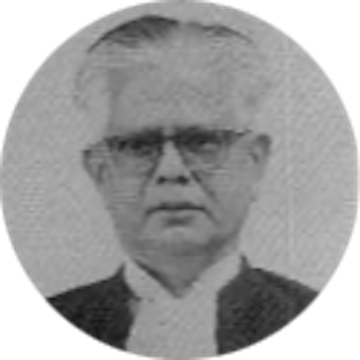J.C. Shah

J.C. Shah
Former Chief Justice of India
Assumed Office17th Dec, 1970
Retired On21st Jan, 1971
Previously
Judge of the Supreme CourtOctober 12th, 1959
Justice of the Bombay High Court1949 to 1959
1948Part of public prosecution team prosecuting the accused, including Nathuram Godse, in the Mahatma Gandhi assassination case
1929Begins practicing law in Ahmedabad
Profile
Born on January 22nd, 1906, Justice Jayantilal Chhotalal Shah served as the 12th Chief Justice of India.
Justice Shah studied law at Mumbai’s Elphinstone college. He began practising law in Ahmedabad in 1929. In 1948, just under two decades into his career, he joined the public prosecution team prosecuting the accused, including Nathuram Godse, in the Mahatma Gandhi assassination case. Subsequently, in 1949, Justice Shah was appointed as a Justice at the Bombay High Court, a position he held until 1959.
On October 12th, 1959, Justice Shah was appointed as a Judge at the Supreme Court. 11 years down the line, he assumed office as the 12th Chief Justice of India on December 17th, 1970. He retired from the position on January 21st, 1971.
During his time at the Supreme Court between 1959 and 1971, Justice Shah authored 728 judgments and sat on 2,094 benches. In 1969, he authored 102 judgments.
Justice Shah predominantly adjudicated on matters of direct taxation, property, and Constitutional Law.
Notable Judgments
On June 19th, 1969, former Prime Minister Indira Gandhi nationalised 14 private banks to finance Indian development. On June 21st, Dr. R.C. Cooper, had filed a writ petition under Article 32 of the Constitution challenging Mrs. Gandhi’s decision on the grounds that his Fundamental Rights, and of “the small man and the small shareholder” had been violated. Dr. Cooper was on the Board of Directors of the Central Bank of India and held shares in two of the other nationalised banks. In R.C. Cooper v. UOI, a Bench led by Justice Shah delivered a landmark 10:1 judgment on the matter on February 2nd, 1970. It ruled that a shareholder could not move the Court to protect their Fundamental Rights in the name of their company, unless the action in question directly or indirectly violated their own Fundamental Rights. Justice A.N. Ray wrote the lone dissenting opinion.
In 1962, Kharak Singh, charged with ‘dacoity’, was brought under the Uttar Pradesh police’s stringent surveillance under Regulation 236 (Chapter 20) of the Uttar Pradesh Police Rules. Singh filed a writ petition before the Supreme Court regarding the constitutional validity of this regulation, which, he argued, violated his Fundamental Right to freedom of movement (Article 21) and to the protection of life and personal liberty (21). In Kharak Singh v. the State of U.P. and Others, 1962, a six-Judge Bench struck down Clause (b), while upholding the rest of Regulation 236. The Bench ruled that the Right to Privacy was not guaranteed by the Constitution, and that surveillance of movement constituted only an invasion of privacy. The dissenting opinion was held by Justices K. Subba Rao and J.C. Shah, who maintained that Article 21 implied the right to be free from direct or indirect encroachments on their person. This landmark Judgment–and dissent–was unearthed in 2017 as the Supreme Court heard challenges to the Aadhaar Act.
The Shah Commission
Upon retirement from the Supreme Court, Justice Shah led the Janata Party-appointed Shah Commission of Inquiry convened on May 28th, 1977 to examine the excesses of the Indira Gandhi-led Emergency.
The Emergency, which was in place in India between June 25th, 1975, to March 21st, 1977, saw the suspension of democratic processes and the commission of grave human rights violations across the country. The Janata Party formed the Union government post the Emergency in March of 1977 and was Mrs. Gandhi’s foremost political opponent at the time.
The third and final report of the Shah Commission—as it is popularly referred to—was tabled in Parliament on August 31st, 1978. Across 26 chapters, the Report examined the detailed extent to which political and civil liberties were quashed by Mrs. Gandhi during these 21 months.
Mrs. Gandhi painted the Shah Commission as a prolonged character assassination of her actions during the Emergency. Down the line, current Congress Working Committee members still argue that Justice Shah was operating at the behest of the Janata Party.
These stances cut against the reality of Justice Shah’s stance during the Emergency, which was somewhat sympathetic towards the State, at the least. For example, in 1976, along with two dozen other public figures, Justice Shah signed a statement calling the Opposition to help Mrs. Gandhi consolidate the “gains” of the Emergency in order to help India successfully transition into a democracy once again. A ‘significant’ act of public resistance during this period was his attending a seminar on “the perils of presidentialism”.
Despite these caveats, the report clearly revealed more than the Union was willing to admit. Upon Mrs. Gandhi’s re-election in 1980, all existing copies of the Shah Commission Report were frantically destroyed by the government. Recent efforts to disseminate the report notwithstanding, with Mrs. Gandhi’s actions, widespread knowledge of the Commission’s findings remains muted. As a result, Justice Shah’s contributions to uncovering what really happened during the Emergency have faded from public memory too.
